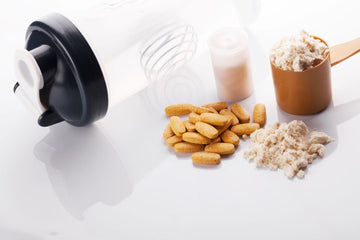The benefits of creatine as a sports nutritional supplement have been in vogue for years. It is one of the compounds most studied and validated by science in its positive effects.
With this guide we show you the benefits of taking creatine, what this nutrient is and how it can help improve physical performance in training.
what is creatine
Creatine is a natural compound that incorporates three amino acids: methionine, arginine and glycine , and is synthesized directly in the body , from the pancreas, liver and kidney, although in small amounts (approximately one gram per day).
Amino acids are the building blocks of protein, skeleton and structure, and protein is the main component that makes up muscle mass . The consumption of creatine, therefore, is a clear recommendation among people who want to improve their physical abilities in all types of sports: strength, speed, resistance, toning...
This compound, due to the body's limited ability to synthesize it by itself, must be ingested through the diet, either through natural foods, such as meat and fish, or through food supplements.
The controlled intake of this substance is positive for athletes and for people with a less active lifestyle, and although it is often associated only with muscle gain, creatine and its benefits are widely validated and contrasted by scientific studies.
In the body, this substance is stored in various tissues and organs, but more than 95% of it is located in skeletal muscle . The daily gram that the body is capable of synthesizing represents around half of the creatine that is metabolized during the day, the rest must be administered via diet or nutritional supplement.
How does creatine work in the body?
This compound is stored in muscle cells as phosphocreatine, a fuel used by the body in high-intensity, anaerobic exercises. Intake through a dietary supplement allows us to store the amount of reserves and favor the production of ATP , the main energy currency of our body.
ATP is adenosine triphosphate , a nucleotide made up of a nitrogenous base, a pentose-like sugar, and three phosphorus atoms. When one of those atoms is broken, it becomes ADP, adenosine diphosphate , releasing the energy required in training sessions.
Free creatine combines with phosphorus, becoming phosphocreatine. In turn, when ATP is broken down, it releases a phosphorous atom and becomes ADP. Phosphorcreatine donates its phosphorus atom to ADP and takes the free atom donated by ATP, thus reproducing the energy cycle.
In this way, if we manage to increase the levels of free creatine in the body , in the skeletal muscle there will also be more phosphocreatine, and with it more possibilities of regenerating ATP.
What effects does creatine have on a workout?
Creatine is a nutritional type ergogenic substance, which means that it is a compound capable of generating force and is designed to improve physical performance beyond normal training . As we will see later, in this case it not only affects better results on a physical level, but also benefits on a mental and organic level.
Its intake in a controlled manner, always under the guidance of a doctor or a nutritionist , and accompanied by intense training with well-planned breaks, results in better physical performance whose main symptom is an increase in muscle mass.
This substance helps overcome phases of stagnation thanks to its ability to provide energy to muscle fibers, delay muscle fatigue and promote blood flow . All of this translates into muscle volume growth, fluid accumulation within the cells, and gains in fat-free muscle mass.
His shots are usually schematized in three ways, beyond the generalized formulas, which we will see later.
- Supplementation for three months , with two to five grams daily, is the most frequent. Then a month of rest is left and the cycle is repeated if necessary.
- Another option is overload supplementation , which is the generalized formula that we will discuss below. This phase is maintained for 12 weeks, always under sports advice.
- Finally, cyclical supplementation consists of taking five grams daily for six weeks and resting for three continuously.
The immediate effect of creatine supplements is the increase in muscle mass, with weight gains of up to 2.5 kilograms . This phenomenon is influenced not only by increased muscle mass, but also by the cell swelling effect that we will see later.
How do you take creatine?
As we have said, the body is capable of synthesizing creatine on its own, but in a small quantity, which is why it is necessary to resort to its intake through the diet and, in many cases, through nutritional and sports supplementation.
In foods, creatine is present in those with the highest protein potential: red meat, lean crystal meat; and fish , especially tuna, salmon, and herring. However, to obtain a sufficient dose of creatine with which to improve athletic performance through diet alone, large amounts must be used.
For this reason, the creatine monohydrate supplement is one of the most practical and functional alternatives to achieve the desired objectives. At Scenit Nutrition we have nutritional supplements designed to meet the demand for this substance and thus improve sports performance in high-intensity exercises.
Best Creatine is a creatine monohydrate supplement with ideal properties for bodybuilders, powerlifters and runners . In this case, its method of use is to take four intakes of five grams during a week and gradually reduce the intakes in the following weeks.
The creatine supplement is shown to be more effective by presenting it in monohydrate mode. To achieve visible results it is important to follow the manufacturer's instructions , but there are also two generalized formulas to increase the deposits of this substance.
- During the loading phase we can go to the intake of 0.3 grams per kilogram of body weight in a period of five to seven days, and continue later with maintenance dose: 0.1 grams per kilogram of body weight .
- The other option is to start directly with the maintenance dose.
Be that as it may, for the benefits of creatine to be more present, the best time to take it is after training, along with a protein or fruit shake. However, this is a personal decision and can be subject to interpretation, as you have to consider how the creatine best fits into the body. There are users who choose to take it before training or during breakfast.
On days of less physical intensity, when there is rest, many athletes decide to halve the dose. Again, this is a personal matter.
As we can see, the key is to correctly calculate the amount of creatine that the body can synthesize through diet and, from there, reinforce this dose with nutritional supplements, always following the manufacturer's recommendations and taking professional advice.
Who can take creatine?
Creatine supplements can be taken by both men and women . All of them seek an immediate improvement in sports performance and faster muscle recovery.
Its intake is not convenient for people under 18 years of age , since there are no studies that validate its use in this age group and the potential associated risks are unknown. Creatine, in general, does not cause toxicity, liver or kidney problems, so its use is safe. In any case, before starting a treatment with this compound it is advisable to ask for nutritional and sports advice.
Creatine and its properties are multiple and validated by prestigious scientific studies. In professional athletes, its consumption can improve sports results, but its effectiveness is reduced among amateurs and adolescent athletes.
Creatine Benefits
Creatine and its properties make this substance interesting both for athletes with a high rate of exercise and for people with a more sedentary lifestyle.
In the first case, in athletes, its supplementation has been shown to be capable of increasing muscle strength and work capacity in total repetitions with maximum loads.
In the organic section itself, the intake of this supplement speeds up the release of calcium ions, which improves muscle contraction and relaxation .
A third benefit is its ability to act as a moisturizing agent inside the cell, which is known as cell swelling and consists of dragging water with it to be stored in skeletal muscle tissues.
Creatine and its benefits in muscle hypertrophy
From a purely protein point of view, creatine generates direct and indirect effects on physical performance, muscle mass and protein synthesis. The cell swelling effect translates into a higher expression of anabolic pathways . In summary, the periodic intake of this supplement increases physical performance and hypertrophic adaptation capacity, that is to say: more efforts, more repetitions, better performance and greater muscle mass.
Likewise, taking creatine in a controlled manner induces better absorption of amino acids from the bloodstream into muscle cells. With this we get an extra in physical performance, since you can work for a longer time at high tension.
The storage of this compound, and hence the suitability of taking it with a food supplement, delays the appearance of lactic acid and allows a longer duration of intense muscular activity. In this way, not only is it possible to increase the training load, but it also allows you to train for longer, since the feeling of fatigue is delayed.
How can creatine intake help in resistance activities?
In sports modalities that have an eminently resistance character, such as running , swimming or triathlon, among others, the benefits of creatine are not so direct , but they are still present.
In these cases, creatine positively affects the muscle glycogen reserve , which is especially important in muscle recovery. Training or long-distance sports events, especially athletics events, recover better if there is a controlled and sufficient intake of this substance, both through diet and through supplements.
Creatine and its benefits at an extra-sports level
Knowing the benefits of creatine in the purely sports field, both for modalities of greater intensity and muscular training as well as in resistance sessions, it is important to point out that this compound is also positive as a health regenerator.
Creatine as a supplement goes beyond improving aerobic and anaerobic performance. It is a compound that helps control sugar levels in the body , especially in people with a very high training rate, as it improves the absorption of sugar in the muscles.
At the brain level, phosphocreatine is directly related to cognitive abilities . A low level of this compound reduces attention span and quick thinking. Therefore, in periods of high intensity, for example weeks of study or a high workload, an extra dose of creatine can help reduce brain fatigue.
One last noteworthy aspect is the ability of creatine and its properties to improve mood. Brain fatigue, and here we spin with the previous point, often induces lack of sleep and uncomfortable rest, which leads to greater chances of suffering depressive episodes, apathy and lack of self-esteem. Again, creatine supplementation, along with a balanced diet, can help reduce these feelings.
The benefits of creatine at the muscle level is what leads many athletes to resort to the intake of this supplement. However, its positive aspects extend beyond physical performance, which makes this substance an increasingly valued supplement.





